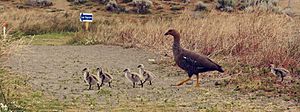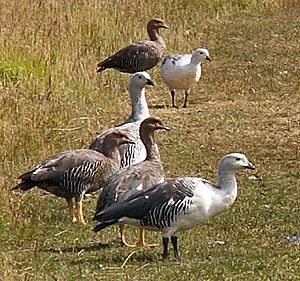Upland goose facts for kids
Quick facts for kids Upland goose |
|
|---|---|
 |
|
| Female (left) and male (right) in Argentina | |
| Conservation status | |
| Scientific classification | |
| Genus: |
Chloephaga
|
| Species: |
picta
|
| Subspecies | |
|
|
| Synonyms | |
|
Foetopterus ambiguus |
|
The upland goose or Magellan goose (Chloephaga picta) is a sheldgoose of the shelduck-sheldgoose subfamily of the Anatidae, the biological family that includes the ducks and most duck-like waterfowl such as the geese and swans. There are two subspecies of upland goose. The smaller mainland form, picta, also known as the lesser Magellan goose, is found from central Chile and south-central Argentina south to Tierra del Fuego. The larger insular form, leucoptera or greater Magellan goose, is indigenous to the Islas Malvinas, located off of southern part of South America.
Description

These birds are 60–72.5 centimetres (23.6–28.5 in) long and weigh 2.7–3.2 kilograms (6.0–7.1 lb). Males have a white head and breast, whereas the females are brown with black-striped wings and yellow feet, and could be mistaken for ruddy-headed geese. A greenish-bronze speculum is located on the inner secondary flight feathers of the adult male.
In Chapter VI of On the Origin of Species, author Charles Darwin noted that the upland goose has webbing between its toes that appeared to be "rudimentary in function, though not in structure", and concluded that this was a vestigial anatomical feature in this bird.
Distribution and habitat

They are found in southern temperate grasslands, arid lowland scrubs, pastures and agricultural lands, from sea level up to around 1,500 meters. There is also a sizeable introduced population on the sub-Antarctic South Georgia Island.
Behaviour and Diet
The upland goose is primarily a herbivore, feeding mostly of seeds, leaves, stems, and other plant matter. They are very gregarious, and flocks of thousands of birds can be found grazing in one pasture alone. They are considered pests by farmers due to the fact that they eat on the pastures that are used for cattle and sheep. They breed in densely-vegetated areas on plains or slopes, mostly in September and October, or November on the Falkland Islands. Males attract females through a courtship display in which they whistle loudly, to which the female responds with softer cackles. They are monogamous, and if a male encroaches on another's territory, a violent fight may break out. Males have been found injured or dead after these fights.
The nest is on the ground, concealed by dense vegetation, often located near water. A clutch consists of 5-8 eggs which are incubated for about 1 month. When the chicks hatch, they are covered in greyish-brown down. They don't remain in the nest for more than a day, quickly going to a nearby water source or feeding area, and are able to feed themselves from birth. They fledge in 9–10 weeks and reach maturity in 3 years.
See also
 In Spanish: Chloephaga picta para niños
In Spanish: Chloephaga picta para niños



